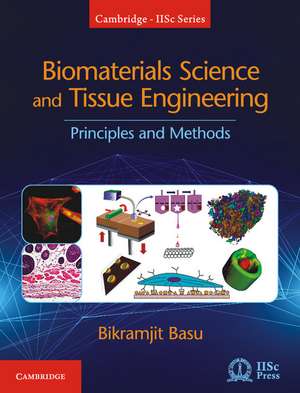Biomaterials Science and Tissue Engineering: Principles and Methods: Cambridge IISc Series
Autor Bikramjit Basuen Limba Engleză Hardback – 14 sep 2017
Preț: 626.81 lei
Preț vechi: 659.80 lei
-5% Nou
Puncte Express: 940
Preț estimativ în valută:
119.96€ • 124.77$ • 99.03£
119.96€ • 124.77$ • 99.03£
Carte disponibilă
Livrare economică 25 martie-08 aprilie
Livrare express 08-14 martie pentru 63.51 lei
Preluare comenzi: 021 569.72.76
Specificații
ISBN-13: 9781108415156
ISBN-10: 1108415156
Pagini: 716
Dimensiuni: 189 x 248 x 35 mm
Greutate: 1.33 kg
Editura: Cambridge University Press
Colecția Cambridge University Press
Seria Cambridge IISc Series
Locul publicării:Cambridge, United Kingdom
ISBN-10: 1108415156
Pagini: 716
Dimensiuni: 189 x 248 x 35 mm
Greutate: 1.33 kg
Editura: Cambridge University Press
Colecția Cambridge University Press
Seria Cambridge IISc Series
Locul publicării:Cambridge, United Kingdom
Cuprins
Foreword I; Foreword II; Preface; Section I. Overview: 1. Introduction; 2. Materials for Biomedical Applications; 3. Tissue Engineering Scaffolds: Principles and Properties; Section II. Fundamentals – Materials Science: 4. Conventional and Advanced Manufacturing of Biomaterials; 5. Probing Structure of Materials at Multiple Length Scales; 6. Mechanical Properties: Principles and Assessment; Section III. Fundamentals – Biological Science: 7. Cells, Proteins and Nucleic Acids: Structure and Properties; 8. Cell-Material Interaction and Biocompatibility; 9. Probing Cell Response, in vitro; 10. Bacterial Growth and Biofilm Formation; 11. Probing Tissue Response, in vivo; Section IV. Illustrative Examples of Biomaterials Development: 12. Case Study: Corrosion and Wear of Selected Ti-alloys; 13. Case Study: Calcium Phosphate–Mullite Composites; 14. Case Study: Compression Moulded HDPE-based Hybrid Biocomposites; 15. Case Study: Phase Stability, Bactericidal and Cytocompatibility of HA–Ag; 16. Case Study: HA-CaTiO3 based Multifunctional Composites; 17. Case Study: Compatibility of Neuronal/Cardiac Cells with Patterned Substrates; 18. Perspectives; Appendix A; Appendix B; References; Index; Colour Plates.
Recenzii
'This book emphasizes the fundamentals of both Materials and Biological Sciences. On the Materials science front, it contains chapters which provide non-specialists with a fundamental understanding on the conventional and advanced manufacturing techniques as well as mechanical properties. Clearly, the strength of this textbook lies in the clear description of the in vitro and in vivo biocompatibility assessment protocols, an asset for non-biologists. The conclusion presents a number of chapters describing case studies, primarily from the author's own research. The number of problem sets and assignments are also important attributes.' Cato T. Laurencin, Chief Executive Officer, Connecticut Institute for Clinical and Translational Science, University of Connecticut
'The book is extremely well structured and every chapter is critical for anyone planning to design medical devices or implants. For example, the inclusion of a chapter on biofilms is a wonderful addition and you will not normally find this in a biomaterials text. For the last thirty years I have been teaching graduate level materials science both in the US and India. This would be a book I would make a mandatory course reference, as I have wanted to include more biological considerations into the standard materials science course.' Shantikumar Nair, Director, Center for Nanosciences, Amrita Vishwa Vidyapeetham University Kochi, India
'The book is extremely well structured and every chapter is critical for anyone planning to design medical devices or implants. For example, the inclusion of a chapter on biofilms is a wonderful addition and you will not normally find this in a biomaterials text. For the last thirty years I have been teaching graduate level materials science both in the US and India. This would be a book I would make a mandatory course reference, as I have wanted to include more biological considerations into the standard materials science course.' Shantikumar Nair, Director, Center for Nanosciences, Amrita Vishwa Vidyapeetham University Kochi, India
Notă biografică
Descriere
Covers key principles and methodologies of biomaterials science and tissue engineering with the help of numerous case studies.






























